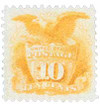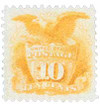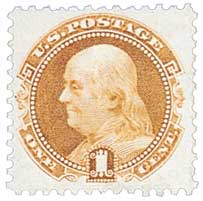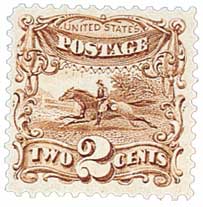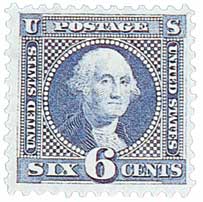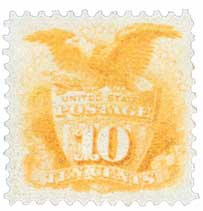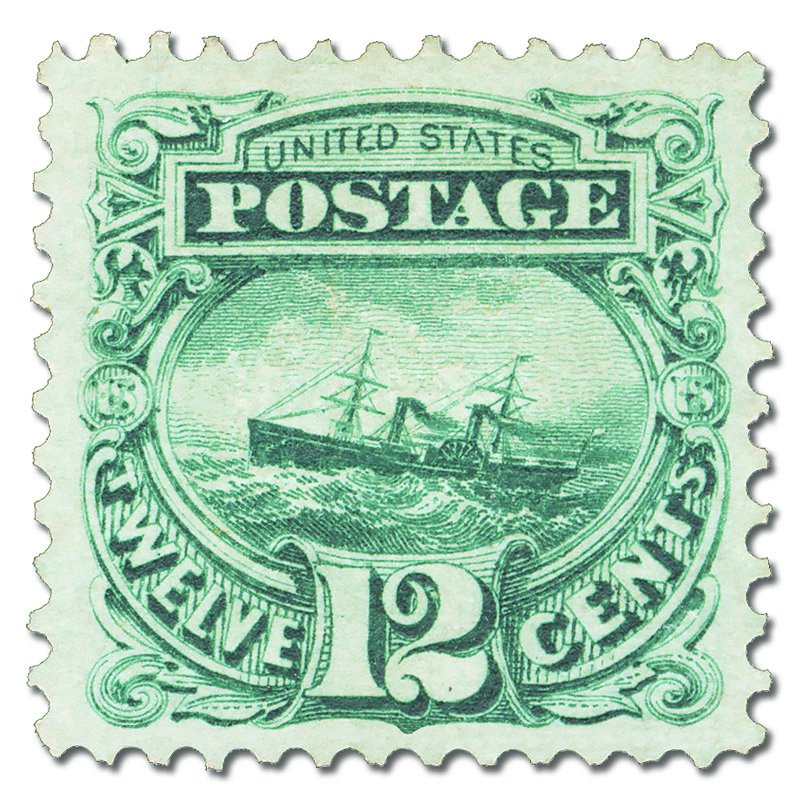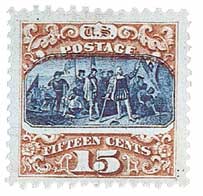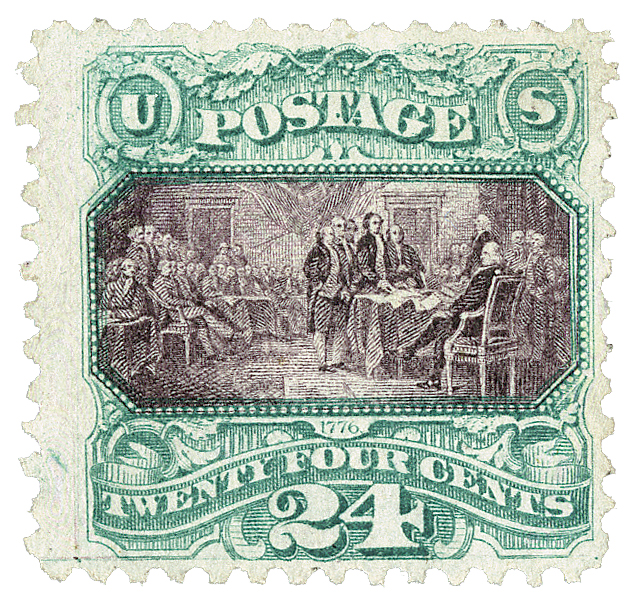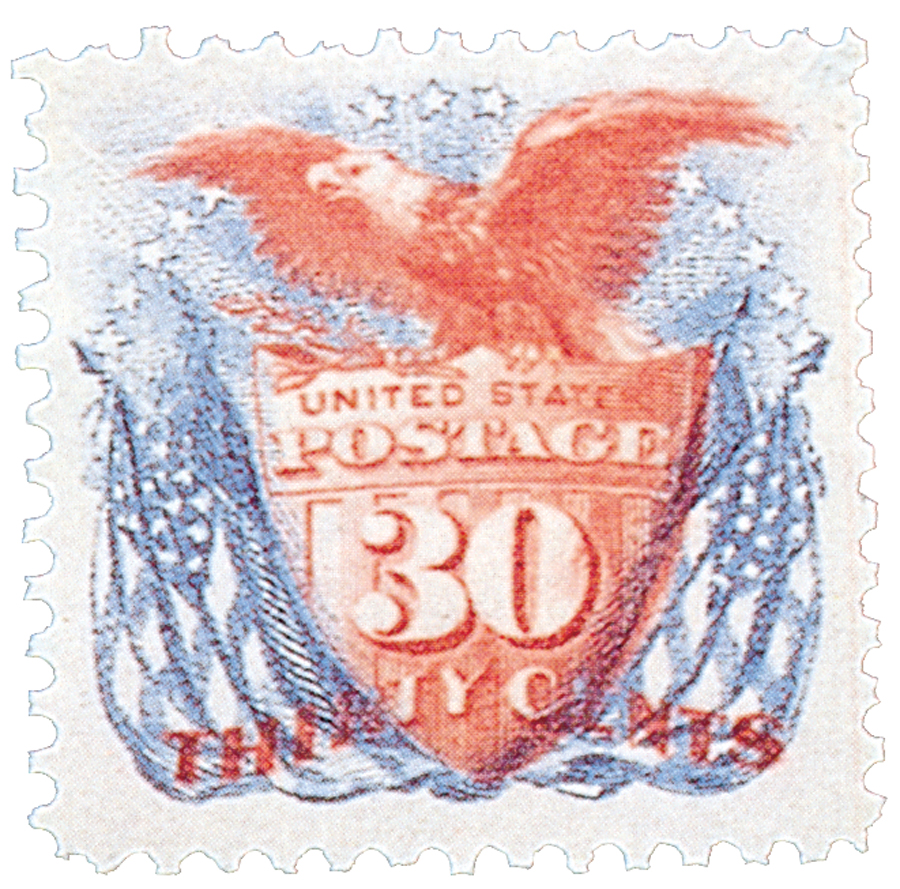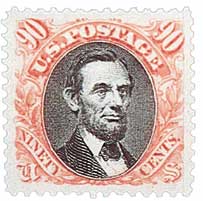
# 116 - 1869 10c Shield and Eagle, yellow
U.S. #116
1869 10¢ Shield and Eagle Pictorial
G Grill
Earliest Known Use: April 1, 1869
Quantity issued: 3,299,550
Printed by: National Bank Note Company
Method: Flat plate
Watermark: None
Perforation: 12
Color: Yellow
Pictorial Series Introduced
On March 19, 1869, the first US Pictorial stamps were issued.
By early 1868, the then-current US definitive stamps had been in use for over six years and their printing plates were quite worn. Additionally, the Post Office’s contract with the National Bank Note Company was set to expire in February 1869. They requested bids for the contract to print new stamps and suggested that “there should be variety in the sizes as well as the designs of the stamps.”
While the previous issues had been produced either in pieces, or as a rushed response to the Civil War, it was suggested that this new series honor the history of the US Post Office – “beginning with Franklin, the Continental postmaster, and the post rider of the early days, followed by the locomotive of a later day and the ocean steamer carrying the mails… the most important scenes in the early history of the country, its triumphant arms, and Washington its first, and Lincoln its last president.”
The National Banknote Company ultimately won the contract and produced the stamps. The majority of the Pictorials were issued on March 19, 1869. Though they initially received some positive reviews, the press criticized them severely. National’s competitor – Butler, Carpenter – may have created some of this negativity. Though Butler, Carpenter had submitted a lower bid to produce the stamps, it’s believed that National may have won because they had the rights to the grilling machines. Butler, Carpenter protested and criticized the stamps publicly, even threatening to launch a congressional investigation.
The press also criticized the stamps, calling them “neither historical, national, [nor] beautiful… What is there in a big chimney on a railroad carriage to indicate the nationality of our postal system?” Other complaints included poor quality gum and jokes that the stamps were so small, people needed to use microscopes to find them in their pocketbooks.
In spite of the negative reaction, the 1869 Pictorials were historic. They were the first US stamps to feature something other than the bust or head of a famous American leader. They were also the first bi-color stamps. Printing with two colors required the stamps to be run through the press twice; once, to print the vignette (center design), and then again, to print the frame.
Carelessness in merging the two impressions resulted in the rare inverts. Instead of an inverted center, the stamp actually has an inverted frame, since the center design was printed first. The 30¢ Shield and Eagle with inverted flags is the rarest of the 1869 inverts. The least obvious of the three, it was the last to be discovered.
The 1869 Pictorials are also the only stamps that feature the “G” grill. In an effort to prevent the reuse of postage stamps, Charles F. Steele invented a device that “grilled” stamps. When the rollers were run over paper, its fibers were broken, leaving a pattern on the paper. Different patterns of grills were used during stamp production and were later identified by a letter. The stamps in this series are the only ones with the “G” pattern on them.
The Pictorials were printed in limited numbers, but they were planned to be produced over a four-year period. Because of their unpopularity, they were removed from sale within a year.
US #120 paid multiple weight rates and was also used as a makeup stamp. One of the finest examples of engraving, the center of the stamp is a miniature masterpiece. James Smillie engraved 42 persons, and the six principal figures can be recognized under a magnifying glass!
The 30¢ Shield and Eagle Pictorial (US #121) was heavily criticized when it was issued. The frame of flags is printed in blue and the shield in red. The design was created so that the denomination – spelled out in red letters – flows over into the blue flag printing. Most of the Pictorial stamps had trouble with the registration of colors, and this is exaggerated on US #121 because of the oddly placed denomination.
The 90¢ Lincoln is the only stamp of the series that didn’t result in inverts. Only one is known on a cover – the legendary “Ice House” cover sent from Boston to Calcutta. The cover was stolen from a collector in 1967 and its whereabouts were unknown until 2006 when an unsuspecting elderly couple brought it to a Chicago-area stamp dealer.
In 1875, all of the Pictorial stamps were re-printed for sale and display at the 1875 Centennial Exposition in Philadelphia. They were issued in very limited quantities – some as few as 1,356. They were printed on hard white paper and were not grilled. Click here to view those stamps.
Click here for a money-saving set of the first six Pictorials.
U.S. #116
1869 10¢ Shield and Eagle Pictorial
G Grill
Earliest Known Use: April 1, 1869
Quantity issued: 3,299,550
Printed by: National Bank Note Company
Method: Flat plate
Watermark: None
Perforation: 12
Color: Yellow
Pictorial Series Introduced
On March 19, 1869, the first US Pictorial stamps were issued.
By early 1868, the then-current US definitive stamps had been in use for over six years and their printing plates were quite worn. Additionally, the Post Office’s contract with the National Bank Note Company was set to expire in February 1869. They requested bids for the contract to print new stamps and suggested that “there should be variety in the sizes as well as the designs of the stamps.”
While the previous issues had been produced either in pieces, or as a rushed response to the Civil War, it was suggested that this new series honor the history of the US Post Office – “beginning with Franklin, the Continental postmaster, and the post rider of the early days, followed by the locomotive of a later day and the ocean steamer carrying the mails… the most important scenes in the early history of the country, its triumphant arms, and Washington its first, and Lincoln its last president.”
The National Banknote Company ultimately won the contract and produced the stamps. The majority of the Pictorials were issued on March 19, 1869. Though they initially received some positive reviews, the press criticized them severely. National’s competitor – Butler, Carpenter – may have created some of this negativity. Though Butler, Carpenter had submitted a lower bid to produce the stamps, it’s believed that National may have won because they had the rights to the grilling machines. Butler, Carpenter protested and criticized the stamps publicly, even threatening to launch a congressional investigation.
The press also criticized the stamps, calling them “neither historical, national, [nor] beautiful… What is there in a big chimney on a railroad carriage to indicate the nationality of our postal system?” Other complaints included poor quality gum and jokes that the stamps were so small, people needed to use microscopes to find them in their pocketbooks.
In spite of the negative reaction, the 1869 Pictorials were historic. They were the first US stamps to feature something other than the bust or head of a famous American leader. They were also the first bi-color stamps. Printing with two colors required the stamps to be run through the press twice; once, to print the vignette (center design), and then again, to print the frame.
Carelessness in merging the two impressions resulted in the rare inverts. Instead of an inverted center, the stamp actually has an inverted frame, since the center design was printed first. The 30¢ Shield and Eagle with inverted flags is the rarest of the 1869 inverts. The least obvious of the three, it was the last to be discovered.
The 1869 Pictorials are also the only stamps that feature the “G” grill. In an effort to prevent the reuse of postage stamps, Charles F. Steele invented a device that “grilled” stamps. When the rollers were run over paper, its fibers were broken, leaving a pattern on the paper. Different patterns of grills were used during stamp production and were later identified by a letter. The stamps in this series are the only ones with the “G” pattern on them.
The Pictorials were printed in limited numbers, but they were planned to be produced over a four-year period. Because of their unpopularity, they were removed from sale within a year.
US #120 paid multiple weight rates and was also used as a makeup stamp. One of the finest examples of engraving, the center of the stamp is a miniature masterpiece. James Smillie engraved 42 persons, and the six principal figures can be recognized under a magnifying glass!
The 30¢ Shield and Eagle Pictorial (US #121) was heavily criticized when it was issued. The frame of flags is printed in blue and the shield in red. The design was created so that the denomination – spelled out in red letters – flows over into the blue flag printing. Most of the Pictorial stamps had trouble with the registration of colors, and this is exaggerated on US #121 because of the oddly placed denomination.
The 90¢ Lincoln is the only stamp of the series that didn’t result in inverts. Only one is known on a cover – the legendary “Ice House” cover sent from Boston to Calcutta. The cover was stolen from a collector in 1967 and its whereabouts were unknown until 2006 when an unsuspecting elderly couple brought it to a Chicago-area stamp dealer.
In 1875, all of the Pictorial stamps were re-printed for sale and display at the 1875 Centennial Exposition in Philadelphia. They were issued in very limited quantities – some as few as 1,356. They were printed on hard white paper and were not grilled. Click here to view those stamps.
Click here for a money-saving set of the first six Pictorials.



